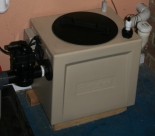Checking and Correcting pH complete package systems from Global Pumps.
Objective: To check and correct the pH levels in trade waste from a business in South Australia to comply with regulations.
The Issue: The trade waste that is dumped into sewage systems of municipalities does impact the quality of water severely. A number of business units in South Australia are involved in the manufacturing of items that have by-products. These being of no use for the business are discharged as trade waste. The waste contains very high levels of bio chemical substances and other hazardous materials. As per the laws in South Australia, it is a mandate to treat these wastes before they are dumped into the sewage system. Effective treatment of wastes calls for special processes. All factories need to install suitable systems in their premises to turn waste by-products into legally acceptable trade waste.
Failure to do so results in legal action.
Requirements that legally acceptable trade waste must fulfil
The Government of South Australia has set criteria to determine the quality of trade waste that can be disposed into sewage systems. To ensure that all manufacturers abide by the rules, samples from the liquid waste emissions of factories are collected by the government agencies of the region, and are tested for qualities that are not permissible. These include:
Physical Characteristics
- Temperature: The average temperature of the trade waste must not exceed 38 degree centigrade.
- Volume: This is variable as it depends on the capacity of the sewage system in which the waste is discharged. Factory managers can check the permissible limit in their areas from the Trade Waste Branch.
- Odour and Colour: This is also determined by Trade Waste Branch on the concerned areas.
Chemical Characteristics
- pH Level: pH range determines the acidity of a chemical solution. The range permitted by the authorities in South Australia for trade waste is 6 to 10 units.
- Greasiness: A litre of trade waste should not contain more than 100 mg of grease or oil.
- Suspended Solids: No more than an average of 500 mg a day of suspended solids should be present in trade waste.
- Total Dissolved Solids: These are different from suspended solids, and not more than 1500 mg of TDS may be present in one litre of trade waste.
- Metals: The highest levels of the respective metals in milligrams that may be present in one litre of trade waste for different metals are as follows:
- Aluminium – 100
- Barium – 20
- Boron – 25
- Cadmium – 10
- Chromium Hexavalent – 10
- Copper – 10
- Lead – 10
- Manganese – 10
- Mercury – 1
- Nickel – 10
- Tin – 50
- Zinc – 10
- Iron – 100
Certain substances fall under no specific category of chemicals. The highest level of these (in milligrams) in a litre of trade waste should be:
- Ammonia – 50
- Chlorine Gas – 5
- Petroleum Hydrocarbons – 30
- Phenolic Compounds – 100
- Formaldehyde as HCHO – 50
- Sulphate – 1500
- Sulphide – 5
- Sulphite – 15
The Solution: The challenge for factories in South Australia is to install a system that can effectively ensure that trade waste has been treated really correctly. It must fulfil all the conditions (as mentioned above) before it is dumped into sewage systems.
The Concept Pump Solenoid Dosing Pump was used to treat the waste from this company. The pump covers a capacity range of 0.6 litres/h-10 bars to 4 litres/h-7 bars. Its compact structure also makes it ideal for use alongside general bracket-mounted installations and chemical storage tanks. Other applications this pump can be used in is grinding systems, car washing systems and rinsing machines.
Working of the pump
Regulation of the required dose is infinitely variable through the stroke length in the range of 10 – 100 %, or can be set at 1 of the 4 settings through the stroke frequency. This offers an adjustment ratio of 1/40. Apart from setting the stroke frequency, the dosing pump may also be set up for use via zero volts contacts, where there is a flow metre or a metering and control system. There is an external control system for this purpose and retrofitting is carried out on the site. A lot of savings can be made on storage costs, thanks to unlimited flexibility.
With the material combination of PPE and NPB for dosing heads, a solution for any kind of dosing function in the area of water treatment is possible.
The Concept dosing pump was used to treat trade waste produced in the factories of South Australia and demonstrated effectiveness.
The Conclusion: Concept Plus does offer unmatched and uncompromising quality at the least possible price. As a feasible solution to treat contaminated trade waste, Concept Plus Dosing Pumps should always be used by factories that plan effective treatment of waste before discharging it into sewage systems. Factory owners also need to realize their responsibilities by treating their trade waste through an efficient dosing system before they discharge it out into the sewage system.


